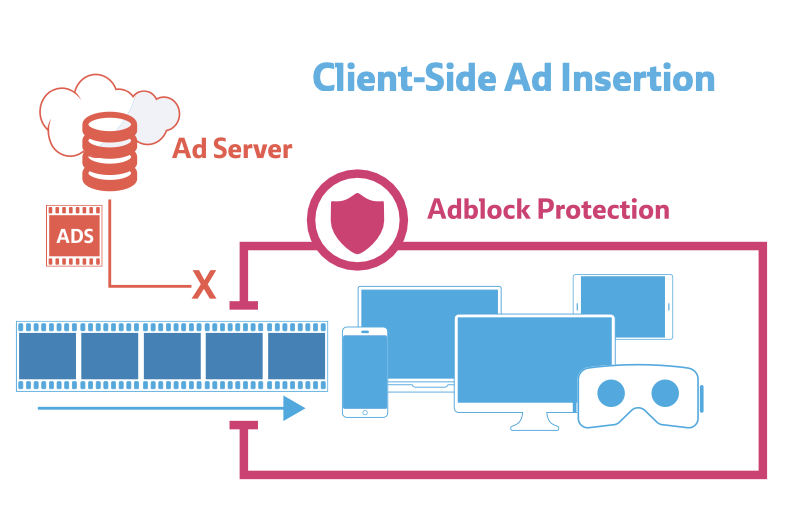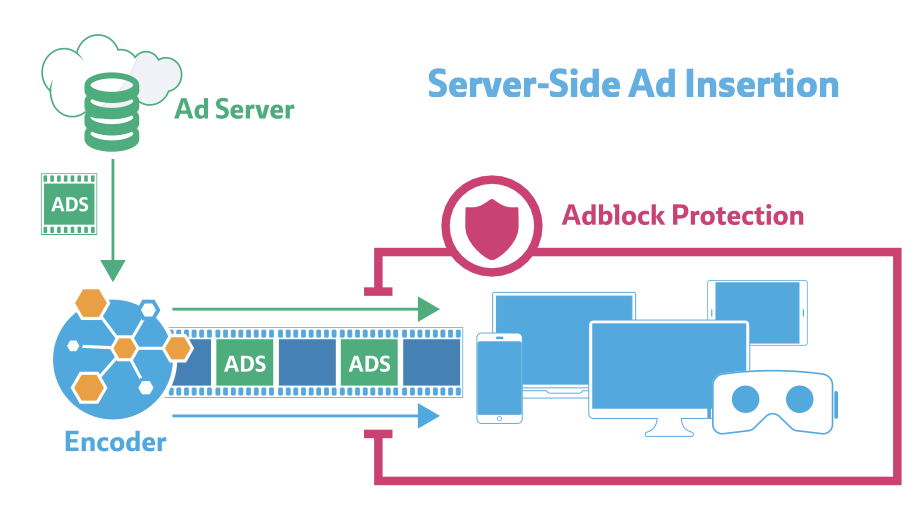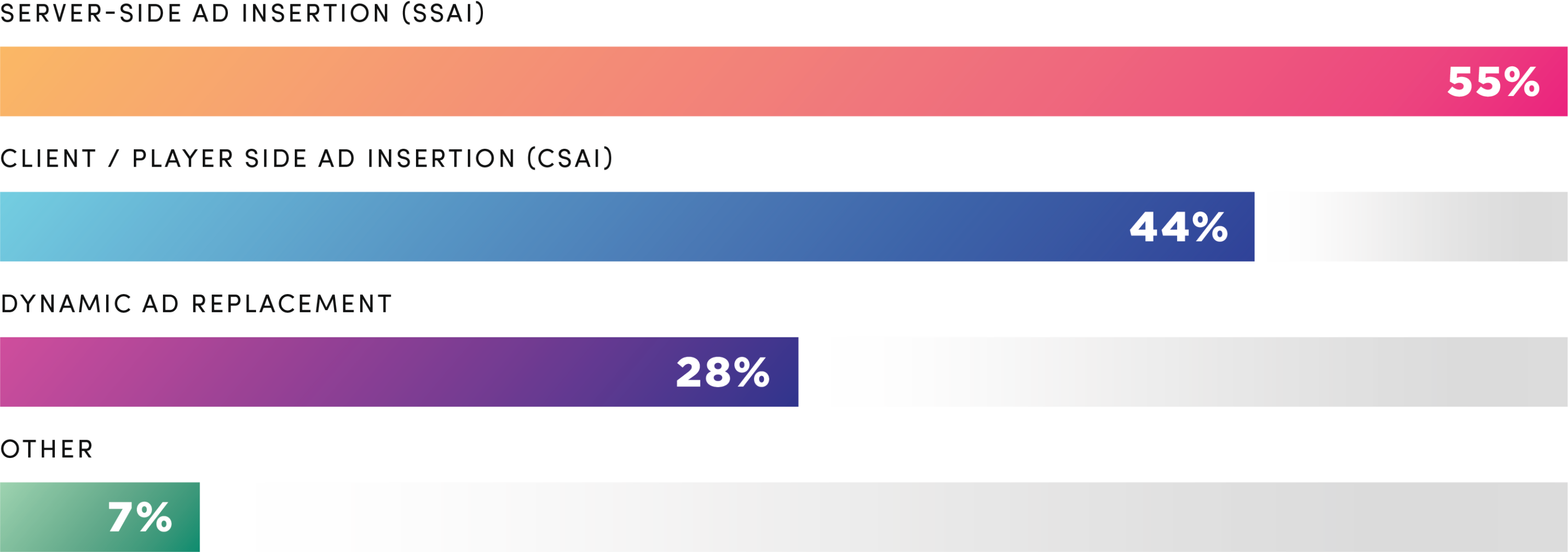Introduction to ad insertion in video streaming
Video streaming has become one of the most engaging ways for people to spend their time and platforms consistently implement ways to monetize it. Whether we watch movies, TV shows, educational videos, or live events, we often encounter advertisements when streaming. However, how these ads are inserted into video streams can vary depending on how the streaming platform builds its video workflow. The main two ad monetization technologies implemented are Client-Side Ad Insertion (CSAI) and Server-Side Ad Insertion (SSAI) and require a video player that supports both to enable playback of the VAST, VMAP, VPAID, or other types of ad standards that are utilized in streaming. Even though player support is essential, ensuring they reach their intended viewers isn’t easy due to blockers built into browsers or devices and other aspects.
In this blog, we will explore what business models correspond with ad monetization, what ad stitching is, what CSAI and SSAI are, how they work, and the different aspects that could affect the choices behind their implementation into video streaming workflows.
Table of Contents
What is ad stitching in CSAI and SSAI monetization methods?
Ad stitching refers to how ads are inserted into on-demand or live video content and is essential for both Client-Side Ad Insertion (CSAI) and Server-Side Ad Insertion (SSAI). The main difference between the two monetization technologies is where the ad stitching occurs in the video workflow.
Regarding CSAI, the ad stitching is handled on the viewer’s device. The video player, which is requesting the stream, also triggers a request for the ad server to send ad content to fit into where the ads are set to be placed (Pre-roll, mid-roll, post-roll). As CSAI can utilize more detailed user data, it can deliver more personalized ads to the viewers in real-time. Once the video player receives the ad content, it blends the ad seamlessly with the main video, ensuring the transition appears natural.
In contrast, SSAI’s ad stitching occurs on the server-side before reaching the viewer’s device. For this to happen, the server requests the video and ad content from their respective servers and then combines them, encoding them into a single stream. This process enables a consistent viewing experience but is limited by not being able to deliver real-time personalized ads like CSAI.
What is client-side ad insertion (CSAI)?
Client-Side Ad Insertion, or Client-Side Ad Stitching, refers to the method where ad requests and stitching happen on the viewer’s device through the video player. This process allows for the delivery of ads with real-time personalization and targeting based on user data generally provided through device cookies or other methods that gather user data.
How does CSAI work?
In CSAI, while the stream is loading on the end user’s device, the video player sends an ad request to an ad server. The ad server then responds with an ad response containing the ad content. Typically, ads are personalized from the user data the ad server has obtained from historical data and their actions. However, this isn’t always possible if an ad blocker or another program restricts the ad server from obtaining the user data. After the ad is received, the video player stitches the ad content with the video content and displays the final stream for the viewer on their device. This process provides a smooth viewing experience as the ads are seamlessly integrated into the stream.
Pros and cons of CSAI
Implementing CSAI into a video workflow gives several advantages to streaming platforms. Personalized ads that can be tailored to the viewer’s preferences and demographics since the ads are stitched on the client-side make up the main benefit. The next is that CSAI enables real-time ad decisioning, meaning that the viewer’s actions can dynamically change what ads are shown in the stream. The third main benefit is that CSAI provides better ad tracking capabilities as it’s done on the device, allowing platforms to give advertisers the ability to measure the effectiveness of their campaigns more accurately through analytics tools.
However, there are also some drawbacks to CSAI. Ad blockers are the most significant issue since the ad stitching happens on the client-side, and ad blocking software can detect and block ads inserted into the stream through this method. As ad revenue is extremely important for any monetization workflow, this poses a challenge for streaming platforms when showcasing the benefit for advertisers. Additionally, client-side ad insertion can impact the overall stream performance as the ad stitching happens in real-time on the end user’s device, which requires more processing power and can result in major issues on the active stream, especially on low-end devices.

What is server-side ad insertion (SSAI)?
Server-Side Ad Insertion, or Server-Side Ad Stitching, refers to the method where ad requests and stitching happen on the server-side rather than on the viewer’s device. This process delivers a single encoded stream to the video player from the video server with the video and ad content together.
How does SSAI work?
In SSAI, the server receives the video and ad content separately from different locations within the workflow. The server then stitches the ad into the video and encodes or transcodes it (depending on whether it’s a live or on-demand video) to create a single stream. Then, the stream is delivered to the video player and displayed to the viewer. This method enables a seamless transition between the video content and the ads, which means an overall better experience for the viewer. To see an example of how this would look, check out the Bitmovin Player’s SSAI demo that showcases how server-side ad insertion is implemented for the stream.

Pros and cons of SSAI
There are a good amount of benefits to implementing SSAI in video workflows. The main one is that ad blockers are less effective as the ad content is inserted on the server-side rather than client-side. This enables more ads to reach the intended audience even if they use ad blocking software on their device. The next is that SSAI provides a consistent viewing experience across different devices and browsers since the ad insertion process is not on the device. Lastly, the processing requirements with SSAI are reduced on the viewer’s device as no stitching takes place, resulting in fewer issues relating to the ads and a better stream performance.
However, just like with CSAI, there are still negatives with server-side ad insertion. One challenge is the need for real-time ad personalization. As the ad stitching happens on the server-side, it is not possible to customize the ads to the user’s preferences, and it will make it less appealing unless the ad contextually fits. Additionally, SSAI may introduce a slight delay between the video content and the ads, which can affect the overall user experience, especially in live streaming scenarios.

CSAI vs SSAI: a comparison
CSAI and SSAI have strengths and weaknesses that make them suitable for different use cases. CSAI excels in providing highly personalized ads and real-time ad decisioning. It allows for seamless integration of ads into the video stream, ensuring a smooth viewing experience. However, as I wrote above, CSAI is more susceptible to ad blockers, requires more processing power on the viewer’s device, and can affect the stream’s overall performance before, during, and after the stream. On the other hand, SSAI offers a more consistent viewing experience across devices and platforms. It is less affected by ad blockers (unless dealing with ad beaconing/ad tracking) and reduces the processing requirements on the viewer’s device. However, SSAI lacks real-time personalization capabilities and may introduce a slight delay between the video content and the ads. Additionally, according to our annual Video Developer Report, there’s a slight preference for SSAI in the industry.

The choice between CSAI and SSAI depends on the specific requirements of the video streaming service and the desired ad experience for their user base. Platforms should consider factors such as ad personalization, ad tracking, performance, and the impact of ad blockers when deciding which method to implement, as it will ultimately affect their revenue stream and the ad possibilities they look to offer.
What are the different business models that use ad monetization?
As the cost of living rises, users are always open to ways to lower their monthly expenses. In our recent research regarding video platforms and streaming services they offer, we found that 58% of respondents supported them having ads within free streams. This corresponds with the growing trend in FAST channels and other business models that have emerged in the streaming industry, which leverage ad monetization strategies. The models either use ads on specific content or have built their entire video workflow on them. These models are:
SVOD: Subscription-based video on demand (and live event sports platforms)
Streaming platforms that fall under this, like HBO Max, Netflix DAZN, ESPN+, FUBO, and others, offer access to video content with a recurring fee. Users pay for access to high-quality content, and depending on whether the stream is live or on-demand, there can be commercials, which commonly air during live sports events.
FAST: Free ad-supported streaming TV
As the newest streaming service category, FAST is the latest business model introduced in the industry. It is a linear channel that delivers scheduled programming similar to traditional TV and doesn’t require any paid subscription. Popular FAST apps include the Roku Channel, Freevee, and Pluto TV. FAST channels are expected to surpass cable, broadcast, and SVOD/AVOD platforms like Hulu in terms of ad spending by 2025.
AVOD: Ad-based video on demand (and live events)
AVOD services rely on commercials and other advertising techniques to generate revenue. This model offers the ability to watch on-demand and even live content rather than linear channels, but viewers must bear with the ads that play before, during, and after their selected streams.
Even though on-demand is the keyword in a couple of them, they also include live streams, especially on live sports platforms, and every streaming provider that has ads on their workflow fits into the definition of these models for their method of revenue generation.
What are the different ad standards and placements delivered with CSAI and SSAI
CSAI and SSAI are just the delivery methods when it comes to getting ads in front of viewers, but let’s take a closer look at what video ad serving protocols are needed and where the ads are typically placed within streams:
Video ad serving protocols
Video ad serving template (VAST):
As a standard XML-based ad format used to serve in-stream ads to players, VAST allows for the seamless integration of ads into video content and supports linear and non-linear ad types. It was created to ensure compatibility between ad servers and video players.
Video multiple ad playlist (VMAP):
When multiple ads appear in a linear sequence, VMAP often plays a role. This ad playlist format lets content owners control the placement and timing of ads. This is often used in conjunction with VAST. See and demo how ad scheduling works with the Bitmovin Player.
Video player-ad interface definition (VPAID):
VPAID is an API standard that allows interactive ad experiences within video players. It enables communication between the video player and the ad creative, allowing ad interactions like clickable ads and interactive elements. Examples of interactive features that might be included in a video ad involve clicking a button to learn more, filling out a subscription form, or completing a survey. VPAID is often used with VAST to ensure compatibility.
Video ad placements
Pre-Roll Ads:
Pre-roll ads are videos that play before the desired video content starts playing. They are typically short, ranging from a few seconds to a couple of minutes, and are meant to capture the viewer’s attention before they engage with the main video content.
Mid-Roll Ads:
Mid-roll ads are videos inserted into the main video content at specific intervals (natural breaks), interrupting the content temporarily. The duration and frequency of mid-roll ads can vary, and they are often used to monetize longer videos or live streams.
Post-Roll Ads:
Post-roll ads are video advertisements that appear after the main video content has concluded. Viewers encounter post-roll ads after they have finished watching the primary video.
The impact of ad blockers on CSAI and SSAI
Ad blockers have been the go-to for many viewers as they’ve gained popularity or are set by default in certain browsers and pose a significant challenge for streaming platforms. These software tools were specifically developed to detect and block ads inserted into video streams, affecting the revenue generated from ad-supported content.
As I wrote earlier, ad blockers affect ad monetization methods differently. CSAI, which inserts ads on the client-side, is more susceptible to ad blocking. SSAI, on the other hand, is less affected by ad blockers because it stitches in the ads at the point of encoding. Ad blockers affect SSAI when ad beaconing (ad tracking) calls are made since this is done through the video player on the client’s device. The way around this specific use case is server-side beaconing, which ad blockers do not affect. Ultimately, this gives platforms using SSAI a better chance of reaching their intended audience, even if they are using ad blockers.
Dynamic ad insertion (DAI) and its role in video streaming
Dynamic Ad Insertion (DAI) is a server-side technology that allows for the insertion of ads into video streams in real-time. Unlike traditional ad insertion methods, it enables ad breaks to be dynamically inserted at specific moments during the video playback. Unlike SSAI, platforms can utilize DAI to precisely target audiences and deliver personalized, relevant ads based on user data and context, helping increase engagement and conversion rates. DAI also provides better ad tracking capabilities to measure campaign performance accurately.
For the viewing experience, DAI seamlessly integrates ads into the stream at natural breakpoints, such as scene changes or transitions, to help keep the user immersed in the stream. The factors that ensure this immersion and are factored in by each development team when implementing it into a video workflow are:
- Ad markers,
- Ad playback,
- Ad break placement
- Ad blocking
If implemented correctly, streaming platforms can deliver a personalized and immersive ad experience to their viewers and keep their advertisers engaged and running campaigns through better ad deployment.
Ad bitrate and its importance in CSAI and SSAI
Ad bitrate refers to the amount of data transmitted per unit of time during the playback of an ad and directly affects the quality of the ad streamed to the viewer as it can enhance the viewer’s experience and increase engagement. In both CSAI and SSAI, Optimizing the bitrate is crucial to ensure that the ads are streamed in the highest quality without buffering or playback issues, which can occur depending on the monetization technology used and available bandwidth.
If the bitrate is too high for the viewer’s internet connection, the ad may buffer or take a long time to load, leading to a poor user experience. On the other hand, if the bitrate is too low, the ad may appear pixelated or lack detail, negatively impacting how the ad is seen. This is where encoding multiple renditions of content and adaptive bitrate streaming come into play as the player will provide the details of the viewer’s streaming capabilities (device type, connection speed, etc.) to the video server or ad server and request the quality that will playback the best.
Ad servers and their role in ad insertion
Ad servers play a crucial role in ad insertion by facilitating the delivery of ads to the video player. They act as a central hub for managing and distributing ad content, ensuring that suitable ads are delivered to the right viewers at the right time. When an Ad server receives ad requests from the video player, it responds with responses containing the desired ad content.
They handle tasks such as:
- Ad targeting,
- Ad tracking
- Ad decisioning
An ad server also plays a role in ad insertion communication between the video player and the server. They facilitate the exchange of data and instructions necessary for seamless ad insertion. This communication ensures that the ads are inserted at the appropriate moments during the video playback, providing a smooth viewing experience. However, a downside to them is that they can negatively impact the performance of the stream by delaying the video start-up time through pre-roll ads. This is because of the real-time bidding that often occurs in the background and stream playback can only happen once that pre-roll ad has been provided to the video player.
Overall, an ad server is essential for effective ad insertion. They enable streaming platforms to deliver ads that are personalized, track the effectiveness of campaigns, and ensure a seamless integration of ads into the video stream.
Ad tracking and analytics for ad insertion
Ad tracking services and analytics tools are crucial for measuring the effectiveness of ad insertion in video streaming. They provide valuable insights into the performance of ad campaigns, allowing streaming platforms and their advertisers to make informed decisions and optimize their strategies. Ad tracking services track various metrics related to ad insertion, such as ad impressions, click-through rates, conversion rates, and revenue generated from ads. These metrics help advertisers understand how their ads perform and whether they reach their intended audience.
Analytics tools provide deeper insights into viewer behavior and engagement during the ad playback. They track metrics such as:
- Video completion rates,
- Time spent watching ads
- Viewer demographics.
- + more
This data is essential and can be used to refine targeting strategies, personalize ads, and improve the overall ad experience.
A great example is Bitmovin’s Analytics, where teams can gain deep insights into each user session and monitor how ads perform on streams during playback. You can see how this would look in our ad event reporting demo. You can also make ad reporting more transparent with the open measurement SDK integrated into the Bitmovin Player and see how it looks in this demo. By leveraging these tools, streaming companies can comprehensively understand their ad campaigns’ performance, leading to a better user experience.
The importance of video players and why their capabilities matter
As we’ve highlighted above, through all of the capabilities necessary for ad playback, video players are crucial in making this all happen. Their integrations and features are pivotal in delivering an ad experience that seamlessly plays back ads and needs to support various ad formats, ensuring that ads are inserted without disruptions. To enable a smooth ad experience, video players should seamlessly handle multiple ad serving protocols and ad placements. Adaptive streaming capabilities are also crucial, as they adapt video quality to varying network conditions, preventing buffering and optimizing user experience during playback.
Not every feature is compatible across every device, but the main capabilities that players should have are:
- Ad Tag Formats (VAST, VPAID)
- Ad Scheduling (VMAP but also manual scheduling)
- Pre-, mid-, post-roll
- Ad Skipping
- Ad Waterfalling to maximize ad revenue
- Ad Pods
- Overlay Ads – (see our demo on this)
- Companion Ads
- Pre-buffering of content coming after ads
- Seamless switching between ads and content, and vice versa
An example of a player that comes with out-of-the-box integrations for CSAI and SSAI is the Bitmovin Player. It covers a broad range of devices and platforms and is built to be adaptive. By providing robust support for CSAI and SSAI, our Player ensures that ads are smoothly integrated into the viewing experience, regardless of the device or platform, ensuring viewer engagement and retention. Below, we’ve listed an overview of the Bitmovin Player’s capabilities by SDK to show how robust it is across each device and platform.
| Player Advertising Capabilities | Web SDK | Mobile Web SDK | iOS & tvOS SDK | Android & AndroidTV SDK | Roku SDK | Smart TVs SDK | Games Console SDK | Set Top Boxes SDK | React Native SDK |
|---|---|---|---|---|---|---|---|---|---|
| Ad Tag Formats (VAST, IMA/IMA DAI) | ✔️ | ✔️ | ✔️ (no DAI built-in) | ✔️ (no DAI built-in) | ✔️ (IMA DAI – SSAI only) | ✔️ | ✔️ | ✔️ | ✔️ (no DAI built in) |
| Ad Scheduling | ✔️ | ✔️ | ✔️ | ✔️ | ✔️ | ✔️ | ✔️ | ✔️ | ✔️ |
| Pre-, Mid-, Post- roll | ✔️ | ✔️ | ✔️ | ✔️ | ✔️ | ✔️ | ✔️ | ✔️ | ✔️ |
| Ad Skipping | ✔️ | ✔️ | ✔️ | ✔️ | ✔️ | ✔️ | ✔️ | ✔️ | ✔️ |
| Ad Waterfalling | ✔️ | ✔️ | ✔️ | ✔️ | ✔️ (DFP waterfall only) | ✔️ | ✔️ | ✔️ | ✔️ |
| Ad Pods | ✔️ | ✔️ | ✔️ | ✔️ | ✔️ | ✔️ | ✔️ | ✔️ | ✔️ |
| Overlay Ads | ✔️ | ✔️ | X* | X* | ✔️ | ✔️ | ✔️ | ✔️ | X* |
| Companion Ads | ✔️ | ✔️ | X* | ✔️ | ✔️ | ✔️ | ✔️ | ✔️ | X* |
| Advertising for Live Video | ✔️ | ✔️ | ✔️ | ✔️ | ✔️ | ✔️ | ✔️ | ✔️ | ✔️ |
*Overlay Ads / Companion Ads on mobile SDKs – technically possible, but value is questionable for UX reasons (overlaying a small screen with an ad is questionable UX)
Companies that focused on enabling CSAI and SSAI ad technology
Currently, there are numerous companies that are focused on CSAI and SSAI technologies. These companies have focused on developing solutions that empower streaming platforms and advertisers to deliver seamless and effective ad experiences. Below, we highlight some key players in this space, categorizing them based on their emphasis on CSAI or SSAI technology.
Companies focused on client-side ad insertion:
- Freewheel
- Spot X
- Spring Serve
- EPOM
- Publica
SSAI Vendors focused on server-side ad insertion
- Yospace
- AWS MediaTailor – (Does CSAI as well)
- Google DAI
- MediaKind Prisma
- Nowtilus
- Broadpeak
The future of ad insertion in video streaming
The future of ad insertion in video streaming for CSAI (Client-Side Ad Insertion) and SSAI (Server-Side Ad Insertion) is already taking shape. The topics and trends that stick out the most are:
Hybrid Approaches:
CSAI and SSAI have their strengths depending on how video platforms want to engage their audience. By taking a dual approach, they can engage and ensure a better quality of experience with more personalization and smoother playback.
AI-Driven Personalization:
AI is becoming a big talking point in the industry now, and advanced algorithms have the potential to refine ad targeting and deliver better, more tailored content to every viewer.
Addressable TV Advertising:
This was major within the traditional TV space, and with the growth of connected TVs, precisely targeting ads to specific demographics and households will continue to expand.
Continued evolution of Programmatic Advertising:
With automation and real-time bidding, efficient and targeted ad delivery will be more streamlined within workflows.
Interactive Ads:
Expect to see more interactive elements within video ads, enhancing viewer engagement and enabling actions directly from the ad, such as making purchases or filling out forms.
The future landscape of ad insertion in video streaming will combine more personalization, improved viewer experiences, and evolving technologies such as VR, AR, and 5g, enabling platforms to engage their audiences with better ad playback.
Conclusion: CSAI vs SSAI
CSAI and SSAI are two effective technologies for implementing ad monetization in video workflows. Each method has strengths that can improve viewer experience and ad engagement; every factor needs to be analyzed when evaluating which is best. The major items that need to be considered are the video player and analytics that focus on playback and monitoring how ads perform in the stream. With our extensive partner network and out-of-the-box integrations for SSAI and CSAI built for the Bitmovin Player, along with the open measurement SDK and the Analytics monitoring for playback with ads, our solutions give platforms the ability to quickly deploy video workflows built for generating revenue through ads.
Find out how our solutions can help you include ads within your streams by signing up for a free trial today.



